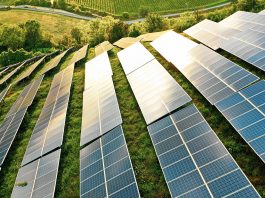Experts from Friedrich-Alexander-Universität Erlangen-Nürnberg (FAU) have innovated a new material that optimises organic photovoltaics.
The FAU researchers have developed acceptor layers comprised of oligomers that increase the performance and long-term stability of organic photovoltaics, a potentially significant breakthrough for harnessing solar energy, as organic photovoltaics are less complex to manufacture than conventional silicon modules. They also have increased versatility as they can be flexible and transparent, making them applicable in tight urban spaces.
The study, ‘Organic solar cells using oligomer acceptors for improved stability and efficiency,’ is published in Nature Energy.
How organic photovoltaics can reinforce our energy systems
The war in Ukraine has highlighted how essential it is to reduce our dependency on fossil fuels and transition to sustainable energy sources. Solar panels offer a promising clean energy alternative; however, limitations of the technology remain, such as needing a higher output and not being suitable for densely populated industrial nations due to their surface area.
To overcome this, scientists have been exploring the potential of organic photovoltaics. In contrast to the silicon used in conventional solar systems, organic photovoltaics are comprised of carbon-based semiconductors that are applied from a solution directly onto a supporting film.
This means they are flexible and can be translucent or transparent so that they can be applied in a range of urban spaces, such as windowpanes. However, identifying the optimal material for the semiconductor layers has plagued researchers.
Professor Christoph Brabec, Chair of Materials Science at FAU and Director of the Helmholtz Institute Erlangen-Nürnberg for Renewable Energy (HI ERN), explained: “For example, if we use polymers with very long chains of molecules, the modules are robust against fluctuations in temperature and have a longer operating life. However, polymers are not very well defined and have more defects due to their complexity, which can lead to lower output in low light levels.”
Oligomers enhance solar cell performance
The researchers experimented with molecules known as oligomers to develop an alternative to electron transfer. Oligomers have shorter chains, meaning they can be designed more accurately and have higher efficiency in near-infrared light than polymer chains. However, the drawback is that oligomers are highly sensitive to fluctuations in temperature and are typically more unstable.
In their study, the team aimed to combine the best of both worlds, creating low-molecule non-fullerene semiconductors that have a high output whilst being robust and durable. They set out to achieve this using a molecule called Y6 that has a symmetrical structure and is made up of carbon, nitrogen, hydrogen, oxygen, sulphur, and bromine atoms.
Difei Zhang, a doctoral candidate who conducted the experiments at FAU, commented: “We modified the molecule in countless tests and examined its properties as an acceptor layer.”
Additionally, the team used two-dimensional wide-angle x-ray scattering measurements to examine the microstructure and behaviour of the molecule chains. This fine-tuning of the molecular structure resulted in the developing of an oligomer known as OY3.
Brabec said: “OY3 has an average performance efficiency of 15%, a value that we have also measured with some other derivatives. However, what also impressed us was its excellent photostability.”
OY3 retained 94% of its original output throughout 200 hours of operation and demonstrated an operating life of more than 25,000 hours. This means that with an average operation of 1,500 hours per year, the operating life is equivalent to more than 16 years.
Brabec concluded: “These parameters are unique for multi-layer organic photovoltaic modules and fulfil all requirements for rapid commercialisation. Our strategy of targeted oligomer design takes organic photovoltaics to a new level of efficiency and brings them very close to practical application.”









